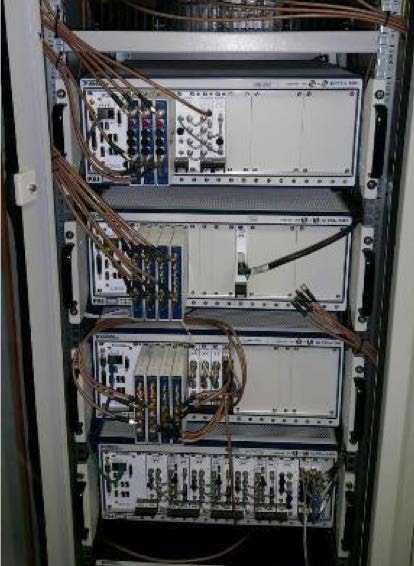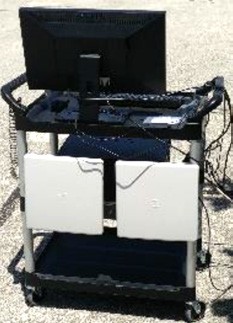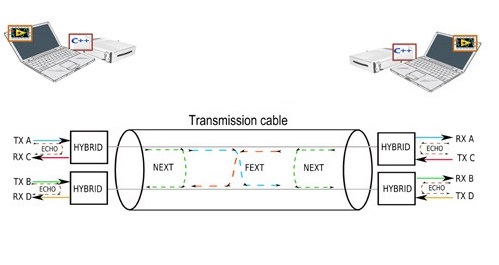Massive MIMO with USRP
Massive MIMO is a technology for increasing the spectral transmission efficiency of mobile communications in urban environments using hundreds of antennas. Massive MIMO researchers appreciate the ability to experimentally test algorithms early - in real-world settings and with real-world signals.

Example of NI SDR equipment in different formats: USRP, ATCA, PXI, FlexRIO, mmWave TS
System equipment
• Transceivers: USRP-294x
• Data transmission: PXIe-1085 chassis, PCI SwitchBox
• Signal processing: FPGA in USRP and FlexRIO, PXIe-8880 controller
• Synchronization: PXIe-6674T, Octoclock CDA-2990
MIMO Application Framework
• Ready open project LabVIEW
• For base station and subscriber devices
• SU-MIMO, MU-MIMO, Massive MIMO
• MIMO encoding
• Advanced Reciprocity Calibration
• Real-time measurements
Early adopters of NI Massive MIMO
University of Bristol, Lund University, British Telecom, Facebook, Samsung, Nokia,
Intel, KU Leuven, MIET.
Record 145 bps / Hz spectral efficiency
Objective: To create a prototype system to achieve a 20x increase in spectrum utilization using Massive MIMO.
Solution: Experimental stand NI MIMO Prototyping System for 128 antennas: 64 USRP running software on LabVIEW for PC and FPGA. Collaboration between the University of Bristol, Lund University and NI.

"The
NI MIMO Prototyping System Integrated HW Platform with MIMO
Application Framework took a lot of the complexity out of
this development."
Paul Harris, CSN Group, Unversity of Bristol
_____________________________________________________
Simulation of the radio environment in real time
Hardware and software modeling of radio systems is used both at the R&D stages and for testing systems. Continuous digital signal processing with low latency is required to ensure correct simulation.
Colosseum - the largest radio channel simulator
Objective: To create a platform for debugging algorithms and holding competitions for SDR + AI teams on shared spectrum use as part of the DARPA Spectrum Collaboration Challenge. Provide mesh connectivity of all 256 channels with 52 TB / s data in real time.
Solution: RF simulator on 128 USRP devices and 8 ATCA-3671 handlers. Synchronization with Octoclock CDA-2990. Scenario control and real-time visualization.

One of the legs of the simulator. Source: Report of GosNIIAS, MAKS-2017
“Designing a system of this scale from scratch
would take years. The alternatives to using
commercial SDRs from NI carried too much
risk and cost. ”
Paul Tilgman, Program Manager,
DARPA Spectrum Collaboration
Simulation of TCAS as part of the aircraft radio environment
Objective: Simulate ambient traffic during a simulated flight. Formation of a response signal in real time. Simulation of the distance to the aircraft (3 μs non-response), bearing (4 copies of the response signal), overlapping responses of up to 4 aircraft.
Solution: Using 4 FlexRIO 5971 transceivers in a MIMO configuration with a common LO, generating and summing responses to FPGAs in real time.

“This simulator is just one of a large simulator of all aircraft radio systems. We created a simulated airplane radio environment to incorporate real radio systems, previously replaced by mathematical models, into the ground test process.
FlexRIO allows us to elegantly solve the assigned tasks within the booth. ”
Lead Project Engineer
Air control for UAVs
Task: Detection and interception of downlink and uplink signals of commercial drones, monitoring their activity, jamming and intercepting control over the radio channel.
Solution: Air monitoring for drones encompasses a wide range of tasks performed by SDR transceivers in a number of private companies and government organizations. Signal detection and interception of GPS coordinates from the downlink channel allows you to see the movements of the vehicles, the substitution of navigation signals together with jamming of the control channel is used to control the flight and to land in the desired place. Full interception of uplink signals allows full control of the device.
SkySafe uses USRP X310 for automotive anti-drone electronic warfare systems.

"The USRP X310 is the only commercially available SDR with sufficient radio and digital processing capabilities to meet the growing demands of countering drone threats."
Scott Torbor, SkySafe CTO
Spatially adaptive television broadcasting: analysis in the hardware-software cycle.
Broadcast antennas are installed based on several planning assumptions that never fully reflect reality. The network is being over-designed, and energy efficiency is decreasing. DVB-T amplifiers are inherently inefficient, exacerbating the problem.
Challenge: Optimize digital network performance by adapting real-time coverage based on user feedback using beamforming techniques
Solution: UE with an Internet connection will transmit the desired quality of service (QoS) metrics to a central controller. Based on this feedback data, broadcast powers and radiation patterns can be altered to optimize the energy efficiency of the broadcast network. This system is designed in such a way as not to require every user in any given area to be able to feed back to the data, limiting infrastructure overhead.


Live TV signal analysis
- Recording the power of the broadcast TV signal in band for 72 hours, using NI-USRP 2920
- Intensity plots and spectrum measurement in LabVIEW
- Allowed to estimate power fluctuations over time and then simulate them in a channel emulator for HIL experiments
Predicted UK DTT Network Energy Savings
- This study has shown that an adaptive system can reduce the ERP of a broadcast tower by 20-35%
- Applying an ERP reduction estimate for the 49 largest UK broadcast stations gives the annual network savings shown in the table
- This is indicates a significant reduction in the UK network's carbon footprint and will result in significant cost savings
ULLA-X: Middleware for large-scale and distributed wireless experiments.
Challenge: Researching wireless systems, in particular, often requires extensive reconfiguration capabilities, but is hampered by disparate controls and domain-specific control tools.
Solution: ULLA-X seamlessly integrates into the NI ecosystem through LabVIEW connectors for the NPSV subsystem.
Controls for new and existing project templates are readily available through the LabVIEW exposition. This enables rapid prototyping using custom radio project templates.

The ULLA-X core interacts with user applications using a standard network protocol. It schedules monitoring tasks, collects device statistics, and responds to changes in state based on trigger events.
The kernel connects to different radio systems through specific modules for each manufacturer, which translate the read and write expressions into the appropriate query or configuration commands. Simple description and configuration files are used to integrate the specifics of the reference design.
ULLA-X offers advanced control capabilities such as automatic detection and distributed control schemes.
Institute for Networked Systems RWTH Aachen University, Germany
Car frontal radar based on IEEE 802.11.
Challenge: NTSB requires frontal collision detection and avoidance on all new vehicles.
MmWave radars are expensive, easy to trick, and not tied to a communications network.
Solution: NI Hardware: USRP RIO (2953R)
NI Software: LabVIEW FPGA 2014
IEEE 802.11 devices are widely available and are IEEE 802.11p compliant. Possible implementation with a narrow bandwidth requirement: 20 MHz in the 5 GHz range. Demonstrated the accuracy of the order of a meter at a distance of up to 50 m in a simulated environment.

Measurement set for IEEE 802.11 RadCom communication: during the measurements, the edges of the antenna were separated by at least 0.5 m.
This research was supported in part by the US Department of Transportation through the Data-Supported Transportation Operations and Planning (D-STOP) Tier 1 University Transportation Center and the Texas Department of Transportation under Project 0-6877 “Communications and Radar-Supported Transportation Operations and Planning (CAR-STOP ) ”. Dr. Daniels also works for Kuma Signals, LLC.
Wireless Networking and Communications Group
University of Texas at Austin
Diversity and coexistence in communication for the Smart Grid.
Objective: Improving the reliability of smart grid communication.

Goal: Integrate smart grid clients
- Scale voltage to energy consumption
- Real-time billing at rates
- Analyze load profiles
- Increase system reliability
Implementation of the project
Wireless / Power
Line Heterogeneity - Non-identical Channel, Noise and Interference Statistics
- Combination Factor Maximization is the best method for maximizing the likelihood for additive Gaussian noise.
- OFDM transmission with 256 subchannels and BPSK modulation
- Sampling rate 0.4 MHz
- Wireless noise model: Gaussian mixture with two components
- Transmission line noise model: cyclostationary noise
Coexistence mechanisms
- 802.11ah and 802.15.4g share the same 900 MHz ISM band - Large outdoor
channel loss model used - The
following interference model is used: d (Rxv, Txv) = dD and d (Rxi, Txi) = dU
- Used metric desired / unwanted signal ratio

Test stand:
- Test bench of real-time hardware and software for wired MIMO OFDM communications
- Evaluated algorithms: bit allocation, time equalization, farend crosstalk cancellation (zero-forcing and successive interference)
Flexible implementation of GFDM on FPGAs with support for runtime reconfiguration
Innovative 5G applications are challenging future cellular systems with new requirements. The OFDM 4G standard cannot cover all of them. Generalized frequency division multiplexing provides flexible waveforms with multiple carriers and additional degrees of freedom. This project presents a flexible FPGA implementation strategy for GFDM, with runtime reconfiguration, using the LabVIEW Communications System Design Suite.
Results
- Flexible design in FPGA
- Parameters tunable at runtime:
- Number of subcarriers K
- Number of subsymbols M
- Pulse shaping filter
- Time window
- Cyclic prefix
- Resource map
- Training sequence
Architecture of broadband distributed shared spectrum systems based on LTE
Objective: To develop a radio architecture for distributed spectrum sharing by secondary users (SUs) in a localized area and wide band.
Solution: The architecture based on the OFDM physical layer allows multiple pairs of users to use one or more sub-channels in-band without causing harmful interference to each other. The architecture is implemented using NI USRP RIO devices and the LabVIEW Communications System Design Suite.
Tests in the LTE Application Framework System show that the spectrum sharing efficiency in the implemented distributed system is close to the upper bound at a sufficiently high signal-to-noise ratio.
- The efficiency of spectrum sensing increases with increasing N
- System performance is higher at N≥M
University of Notre Dame
TOUCAN Wireless SDN Test Bench: Multi-Technology Platform
A task:
- Achieve maximum network convergence provided by a radically new technology-agnostic architecture for a wide range of end-user applications and services
- Promote optimal interconnection of network technology domains, network devices and datasets with high flexibility, bandwidth, high adaptability, resource and energy efficiency
- Overcome traditional barriers between equipment and service infrastructure by integrating and managing network infrastructure into an end-to-end service chain
- Seamlessly converging disparate technology domains
- Maintain very high throughput, granularity and capacity

Solution: TOUCAN Wireless SDN Test Bench
- Part of the TOUCAN LAB, a unique large-scale experimental multi-technology platform designed to test, refine and demonstrate new solutions developed within the TOUCAN tasks
- An experimental platform that combines wireless and optical communication with IT, integrating them both on hardware and software level
- A multi-technology emulation tool capable of supporting various TOUCAN technologies in scale and in real time
- An experimental platform open to experimentation in all layers and fields, offering researchers complete control and programmability to create a multifunctional unique research Wednesday
Communication Systems and Networks Group, University of Bristol
Non-contact breath detection with passive radar
Applications:
- Non-contact breathing detection is essential in critical care monitoring, long-term monitoring, as well as in other non-clinical areas such as monitoring the health of workers (airplane pilots, firefighters, etc.)
- Passive radar allows the detection system to work without special devices and without signal sources
Solution: Model of a passive radar system.
- Source - Energy
Harvesting Transmitter - Receiver - Data received from two USRP-2921 devices


The proposed breathing detection system provides a high correlation of the respiratory signal up to 60 cm and the correct respiratory rate up to 100 cm.
The proposed system operates in real time with a speed of 5 readings per second.
Communication Systems and Networks Group, University of Bristol


